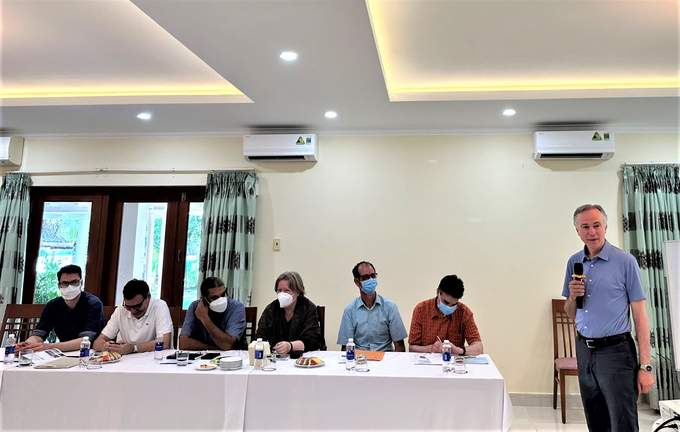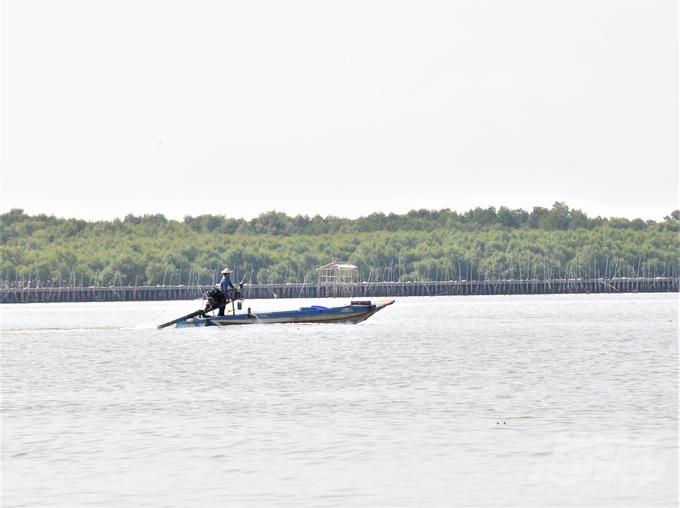November 24, 2025 | 08:13 GMT +7
November 24, 2025 | 08:13 GMT +7
Hotline: 0913.378.918
November 24, 2025 | 08:13 GMT +7
Hotline: 0913.378.918
The Federal Ministry for Economic Cooperation and Development of Germany (BMZ), represented by Dr. Andreas Foerster, recently traveled to Kien Giang province to visit a number of German-Vietnamese cooperation projects. The Integrated Coastal Protection and Mangrove Belt Rehabilitation Project for Kien Giang and Ca Mau provinces was one of their destinations. According to Dr. Andreas Foerster, BMZ has accompanied Vietnam in implementing projects to respond to climate change over the past few years.

The Federal Ministry for Economic Cooperation and Development of Germany discussing ongoing German-Vietnamese cooperation project with Kien Giang province, including the restoration and protection of coastal forests. Photo: Trung Chanh.
The Integrated Coastal Protection and Mangrove Belt Rehabilitation Project for Kien Giang and Ca Mau provinces is funded by an ODA loan from the German Government, through the Federal Ministry for Economic Cooperation and Development of Germany. This is the first project in the region to apply structural and non-structural solutions to achieve prevent natural disasters, combat erosion, restore mangrove and protect coastal forests. The project will help implement the Government's Resolution No. 120/NQ-CP on Mekong Delta Sustainable Development to Adapt to Climate Change.
The Integrated Coastal Protection and Mangrove Belt Rehabilitation Project for Kien Giang and Ca Mau provinces has a total capital of 24 million Euros, which is equivalent to nearly 600 billion VND. The project capital consists of the German Government's preferential loan of 18 million Euros and the Vietnamese government's counterpart capital of 6 million Euros. Due to the project's deadline of December 2025, stakeholders are maximizing human resources to expedite project implementation.
The completed project will contribute to sea dyke protection; natural disaster mitigation; field protection for 298,500 hectares of aquaculture and 55,900 hectares of rice; adaptation to climate change and the rising sea level.
Regarding coastal forest protection, approximately 2,800 hectares of forest are under development and protection. Additionally, the project plans to upgrade and renovate 19 kilometers of sea dykes and breakwaters. Ultimately, the project will benefit 18,000 people in 14 communes and 6 districts within Kien Giang and Ca Mau provinces.

According to the project, approximately 2,800 hectares of forest are under development and protection. Additionally, the project plans to upgrade and renovate 19 kilometers of sea dykes and breakwaters. Photo: Trung Chanh.
The local project component in Kien Giang province has a total investment capital of 9.3 million Euro, which is equivalent to 230.9 billion VND; 7 million of which is an ODA loan from the German government, and the remaining funds are provided by local counterparts. This project will focus on sea dyke restoration, and forest development. Moreover, the forest will contract to protect 1000 hectares of forest, establish 1,600 hectares of forest, and grow 5 million scattered trees. A combined model of agriculture, forestry and fishery is also in development to support the livelihood of coastal communities
Mr. Le Huu Toan, Deputy Director of Kien Giang Department of Agriculture and Rural Development, said: Kien Giang is the largest province in the Mekong Delta with a coastline of 200 km. Kien Giang's main strength is its agricultural economy, with 71% of its local people living on agricultural production. As a result, climate change has had a great impact on production and people's lives.
International cooperation organizations have implemented various climate change adaptation programs in Kien Giang province. Namely, BMZ has supported Kien Giang province with many projects in the fields of agriculture and forestry, production restructuring, climate change adaptation and the environment.
According to the project, Kien Giang province will prioritize 3 main categories: Build and strengthen sea dykes in combination with grade 4 roads, build protective breakwaters, prevent coastal erosion, and create coastal alluvial forest; Review coastal zoning, plant new forests and trees in order to maximize the coastal protection forest belt; promote sustainable development livelihood models for people in coastal areas.
Regarding coastal protection, the project offers more resilient and economically viable solutions. This includes building and upgrading existing sea dykes to level 2 sea dykes; planting, protecting and developing coastal protection forests; Improving human resources and efficiency in forest management; Improving the livelihoods of coastal communities through sustainable livelihood models.
Translated by Nguyen Hai Long
/2025/11/22/4018-4-213342_747.jpg)
(VAN) The Mekong Delta Agricultural Experts Club has attracted 143 experts and researchers to participate in providing consultancy and contributing initiatives to the development of one million hectares of high-quality rice.

(VAN) Ca Mau’s development of OCOP products opens a path to increasing cooperatives value, helping boost income, expand markets, and affirm collective economy's role.

(VAN) Turning seemingly ordinary coconut shells into unique jewelry and artwork, Nguyen Bang Nhi spreads the value of local culture through her brand, Cocohand.

(VAN) Results from the Sustainable Durian Model Project in Dak Lak have confirmed the critical role of Yara Viet Nam in transferring advanced nutritional solutions to farmers.

(VAN) In Tuyen Quang province, livestock farmers have introduced effective models and innovative practices that significantly strengthen African Swine Fever prevention and control efforts.

(VAN) This is the study conducted by IRRI and Can Tho University on the rice straw value chain in Mekong Delta showing an economic potential of more than 6.6 trillion VND/year.

(VAN) By participating in cooperative economics, many farmers in Tay Ninh have overcome hardship, mastered clean dragon fruit cultivation techniques.